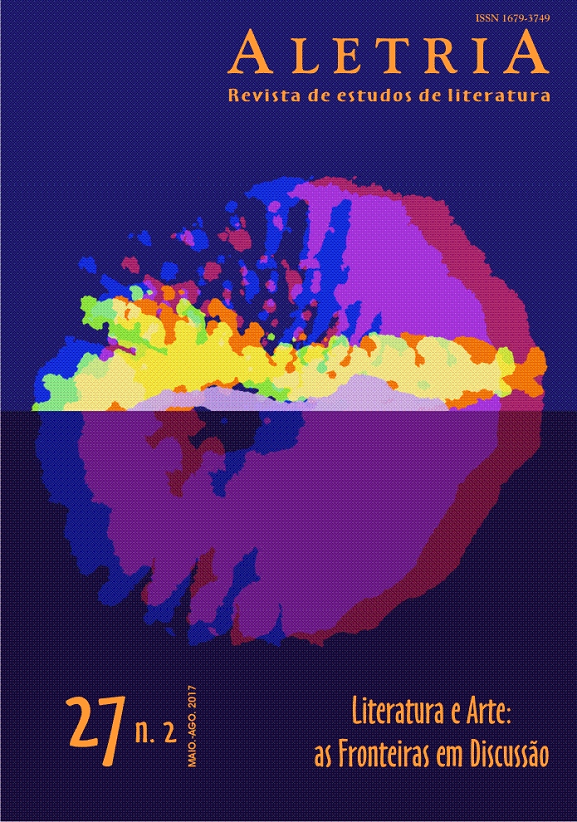More Than a Soundtrack: Music Between Text and Image in Environmental Art
DOI:
https://doi.org/10.17851/2317-2096.27.2.141-155Palabras clave:
music, text, image, Anthropocene, climate, performativity.Resumen
Music has rarely been the subject of analysis in environmental art forms, from film to post-apocalyptic fiction. This article seeks to fill that gap and shows how music functions between word and image, using three case studies: The Crossroads Project, a lecture-performance series on climate crisis; Trinity, a short documentary video on the history of nuclear testing; and Lidia Yuknavitch’s The Book of Joan, a dystopian novel with music at its core. In all three examples, music does not work as atmospheric background but rather as an active mediator in its own right. Entering the spaces between text or spoken word and image with unexpected material presence, it can help to open the audience toward greater urgency or inquiry about climate disruption; it can accumulate intensity as viewers watch and hear data on nuclear testing; it can even incite violence within a narrative, both thematically and in the text itself, as Sybille Krämer has noted in her work on performativity. Though activist art can easily become baldly manipulative, music can “expose” its hearers (to use Stacy Alaimo’s and Jean-Luc Nancy’s term) to planetary threats in a way that fosters critical, not just sentimental or fearful, response.
Descargas
Citas
A WIDE-ANGLE view of fragile Earth. Yann Arthur Bertrand. 2009. 14 min. Available at: https://www.ted.com/talks/yann_arthus_bertrand_ captures_fragile_earth_in_wide_angle. Accessed: 2 May 2017.
ALAIMO, Stacy. Exposed: Environmental Politics & Pleasures in Posthuman Times. Minneapolis; London: University of Minnesota Press, 2016.
BELTING, Hans. Likeness and Presence. Translated by Edmund Jephcott. Chicago; London: University of Chicago Press, 1994.
BRUHN, Jørgen. Now a Major Soundtrack! – Madness, Music, and Ideology in Shutter Island. Adaptation, Oxford Academic, v. 6, n. 3, p. 320-337, 2013. DOI: https://doi.org/10.1093/adaptation/apt013.
BRUHN, Jørgen. The Intermediality of Narrative Literature. London: Palgrave Macmillan, 2016.
DAVIES, Robert. The Crossroads Project Booklet. Available at: http://www.thecrossroadsproject.org/uploads/1/9/2/1/19217933/crossroads_booklet.pdf. Accessed: 1 May 2017.
HADLAND, Nick. More than Noise: The Integrated Soundtrack of Noise. Screen Sound Journal, Australia, n. 1, p. 35-46, 2010.
HARAWAY, Donna. The Promises of Monsters: A Regenerative Politics for Inappropriate/d Others. In: GROSSBERG, Lawrence; NELSON, Cary; TREICHLER, Paula A. (Ed.). Cultural Studies. New York: Routledge, 1992. p. 295-337.
HART, Heidi. Mozart on ice: Mus ic as Anthropocene artifact in Expedition to the End of the World. Ekfrase: Nordic Journal for Visual Culture, Oslo, v. 6, n. 1-2, p. 38-48, 2017. Doi: 10.18261/issn.1891-5760-2016-01-02-05.
HART, Heidi. Nuclear Music. Pressure Waves: Tracking Art for Change, 3 November 2015. Available at: https://pressurewavesblog.wordpress. com/2015/11/03/nuclear-music. Accessed: 30 Apr. 2017.
KRAMER, Lawrence. Classical Music and Postmodern Knowledge. Berkeley: University of California Press, 1995.
KRÄMER, Sybille. Medium Bote Übertragung: Kleine Metaphysik der Medialität. Frankfurt/Main: Suhrkamp, 2008.
KRÄMER, Sybille. Was haben “Performativität” und “Medialität” miteinander zu tun? Plädoyer für eine in der “Aisthetisierung” gründende Konzeption des Performativen. In: Performativität und medialität. Edited by Sybille Krämer. Munich: Wilhelm Fink Verlag, 2004. p. 11-32.
LABELLE, Brandon. Background Noise: Perspectives on Sound Art. London; New York: Bloomsbury, 2006.
MCLUHAN, Marshall. Understanding media: The Extensions of Man. Corte Madera, CA: Gingko Press, 2003.
MORTON, Timothy. Hyperobjects: Philosophy and Ecology after the End of the World. Minneapolis: University of Minnesota Press, 2013.
NANCY, Jean-Luc. The Existence of the World Is Always Unexpected: Jean-Luc Nancy in conversation with John Paul Ricco. Translated by Jeffrey Malecki. In: DAVIS, Heather; TURPIN, Etienne (Ed.). Art in the Anthropocene: Encounters Among Aesthetics, Politics, Environments and Epistemologies. London: Open Humanities Press, 2015. p. 85-92.
REYBROUCK, Mark; EEROLA, Tuomas. Music and Its Inductive Power: A Psychobiological and Evolutionary Approach to Musical Emotions. Frontiers in Psychology, Frontiers Media, v. 8, p. 1-14, 2017.
SCHAFER, R. Murray. The Soundscape: The Tuning of the World. Rochester, Vermont: Destiny Books, 1994.
SCHIRRMACHER, Beate. The Transmedial Common Ground of Intermedial References: Performativity in Elfriede Jelinek’s Die Klavierspielerin. 2016. Manuscript.
THE CROSSROADS PROJECT. The performance. Available at: http://www.thecrossroadsproject.org/performance.html#music. Accessed: 1 May 2017.
TRINITY. Orbital Mechanics. 14 min. Available at: https://vimeo. com/135580602. Accessed: 30 Apr. 2017.
VANDERMEER, Jeff. The Girl on Fire: The Book of Joan by Lidia Yuknavitch. The New York Times Book Review, New York Times Co., p. 1; 22, 30 April 2017.
WALKER, Elsie. Understanding Sound Tracks Through Film Theory. Oxford; London: Oxford University Press, 2015.
YUKNAVITCH, Lidia. The Book of Joan. New York: HarperCollins.
Descargas
Archivos adicionales
Publicado
Cómo citar
Número
Sección
Licencia
Derechos de autor 2017 Heidi Hart (Autor)

Esta obra está bajo una licencia internacional Creative Commons Atribución 4.0.
Authors who publish with this journal agree to the following terms:Authors retain copyright and grant the journal right of first publication with the work simultaneously licensed under a Creative Commons Attribution Non-Commercial No Derivatives License that allows others to share the work with an acknowledgement of the work's authorship and initial publication in this journal.Authors are able to enter into separate, additional contractual arrangements for the non-exclusive distribution of the journal's published version of the work (e.g., post it to an institutional repository or publish it in a book), with an acknowledgement of its initial publication in this journal.Authors are permitted and encouraged to post their work online (e.g., in institutional repositories or on their website) prior to and during the submission process, as it can lead to productive exchanges, as well as earlier and greater citation of published work (See The Effect of Open Access).





